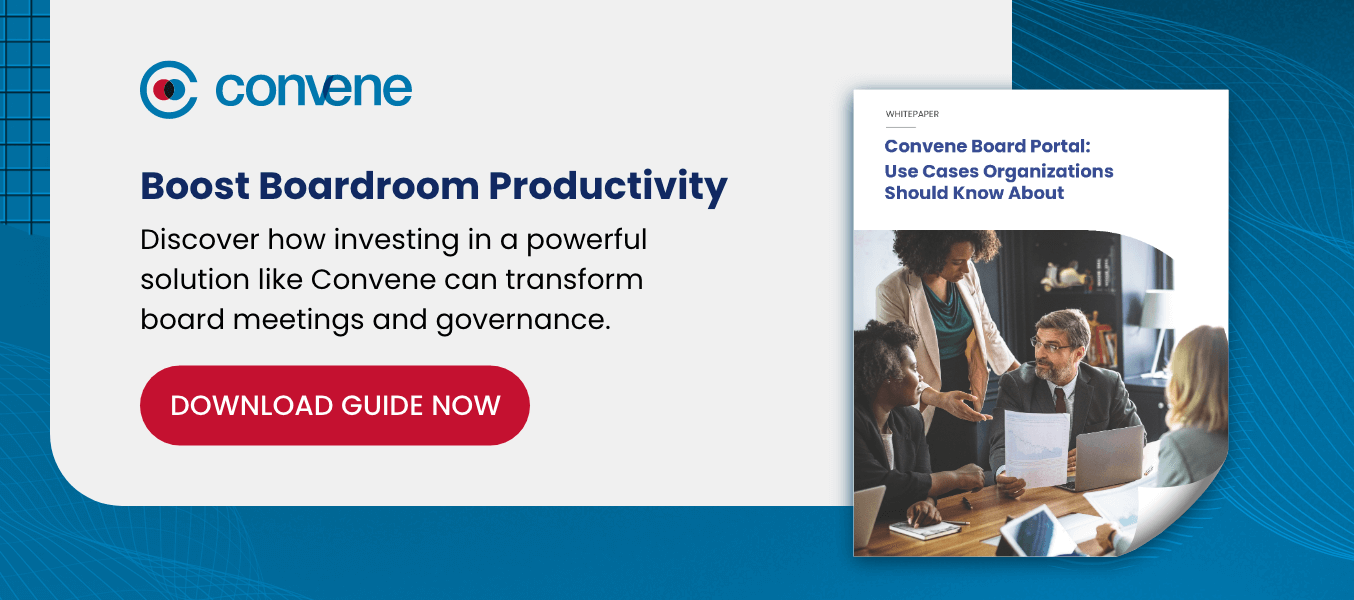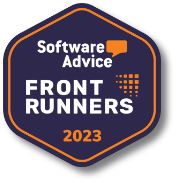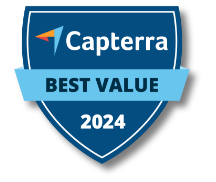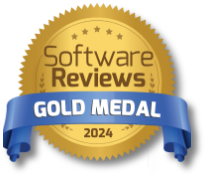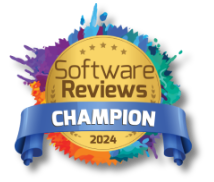Companies and nonprofits use two fundamental concepts to build purpose-driven organizations: vision and mission statements.
Both of these empower leaders to define targeted strategic direction and enhance public perception. Research shows that 82% of employees are likely to engage with organizations with a clearly defined purpose. This trend has become apparent since 2020 and is expected to continue in the future, highlighting the importance of vision and mission statements in positioning organizations for long-term growth.
Often interchanged, these statements have different intents. A mission statement expresses a core purpose and values, and a vision statement expresses the aspirational goals.
Learn in this article what vision and mission statements are, how to write them for your organization, and discover the difference between vision and mission statement, as well as examples from top companies, and their benefits.
What is a vision statement?
A vision statement describes the ideal future and the impact an organization aims to achieve in the coming years. Describing with a broader perspective, it steers decision-makers and employees to remain committed to their long-term objectives while progressing in the present.
Corporations and nonprofits craft vision statements to be:
- Ambitious: It should be compelling and meaningful to spark confidence, passion, and commitment among board members, investors, and employees.
- Feasible: Leaders must consider market conditions and potential challenges to ensure the statement revolves around realistic timeframes and resource availability.
- Strategic: Its purpose and desired impact must target the organization’s long-term business goals to lead stakeholders in the right direction effectively.
How To Write an Effective Vision Statement

Framing an effective vision statement requires thoughtful strategy and alignment with organizational goals. Here are proven steps as a guide to creating a well-crafted vision statement.
1. Involve stakeholders
Involve stakeholders in developing a vision statement to encourage more buy-in. For nonprofits, this may include volunteers, donors, and community members. In corporate settings, consider engaging department leads and shareholders. By gathering diverse perspectives, organizations can create a vision that resonates with everyone, from co-founders and directors to high-level employees and frontline staff.
Utilizing board portals can facilitate these discussions, enabling seamless communication and collaboration. Modern board portals allow stakeholders to share feedback, contribute ideas, and stay aligned on the vision development process, ensuring everyone’s voice is heard and considered.
2. Define the purpose
A clear purpose is essential to delivering a compelling vision statement that resonates with the target market. Collaborate with decision-makers to unveil the motivations behind why your organization exists.
Here are guide questions you can use in your brainstorming sessions.
- What is the core purpose of the organization?
- What does the organization hope to achieve?
- What core values must we reflect in our vision statement?
- How does the vision statement align with our organization’s culture?
- Do our strategic goals for the next five to ten years support our claims in the vision statement?
3. Set achievable and clear objectives
Base your vision statement on a realistic roadmap. An overly ambitious can affect decision-making and undermine stakeholders, hampering overall progress. By setting achievable and clear objectives, teams can follow a solid blueprint that streamlines progress monitoring and keeps everyone on board driven for the long term.
4. Draft the statement
Translate the insights from brainstorming sessions into sentences and order them according to significance. This approach highlights critical ideas, helping leaders write a convincing vision statement that conveys the brand’s strategic goals.
After, refine the sentences into a single cohesive statement. Use simple language by avoiding jargon and complex words to make it relatable even to people outside your industry, fostering inclusivity and a stronger sense of purpose. Keep vision statements succinct by limiting them to one to three sentences. This ensures they are long enough to clearly convey the vision while remaining concise enough to be memorable.
5. Encourage constructive feedback
Be open to constructive criticism and gather feedback from key departments to help assess whether a draft needs to be more specific or ambitious. This ensures the vision statement is well-balanced, achievable, and inspiring.
Vision Statement Examples
Below are examples of vision statements from well-known private corporations, nonprofits, and educational institutions that showcase various approaches to articulating future goals and values.
- Walmart Inc.: “To become the best at delivering value to our customers, to learn how to sell for less, and to provide the best customer service possible.”
- Amazon.com, Inc.: “To become earth’s best employer and earth’s safest place to work.”
- Google LLC: “To provide access to the world’s information in one click.”
- Apple Inc.: “To make the best products on earth and to leave the world better than we found it.”
- Walt Disney Company: “To be one of the world’s leading producers and providers of entertainment and information.”
- LinkedIn: “Create economic opportunity for every member of the global workforce.”
- Habitat for Humanity: “A world where everyone has a decent place to live.”
- Harvard College: “Harvard College sets the standard for residential liberal arts and sciences education. We have committed to creating and sustaining the conditions that enable all Harvard College students to experience an unparalleled educational journey that is intellectually, socially, and personally transformative.”
- Alzheimer’s Association: “A world without Alzheimer’s and all other dementia.”
- American Red Cross: “We always aim to prevent and relieve suffering with every action.”
What is a mission statement?
A mission statement explains the advocacy of an organization, telling what it does and how it intends to serve its stakeholders. Created to support the vision statement, it bridges the gap between current actions and future aspirations by defining concrete steps to progress and deliver value.
Attributes of an effective mission statement are:
- Actionable: It must set clear objectives, enabling relevant parties to execute them effectively and efficiently.
- Inclusive: Create an appealing mission statement to cultivate trust and promote ethical conduct from stakeholders.
- Unique: Write a mission statement according to your unique goals, products, and principles to make it more memorable for the public.
How to Write a Clear Mission Statement
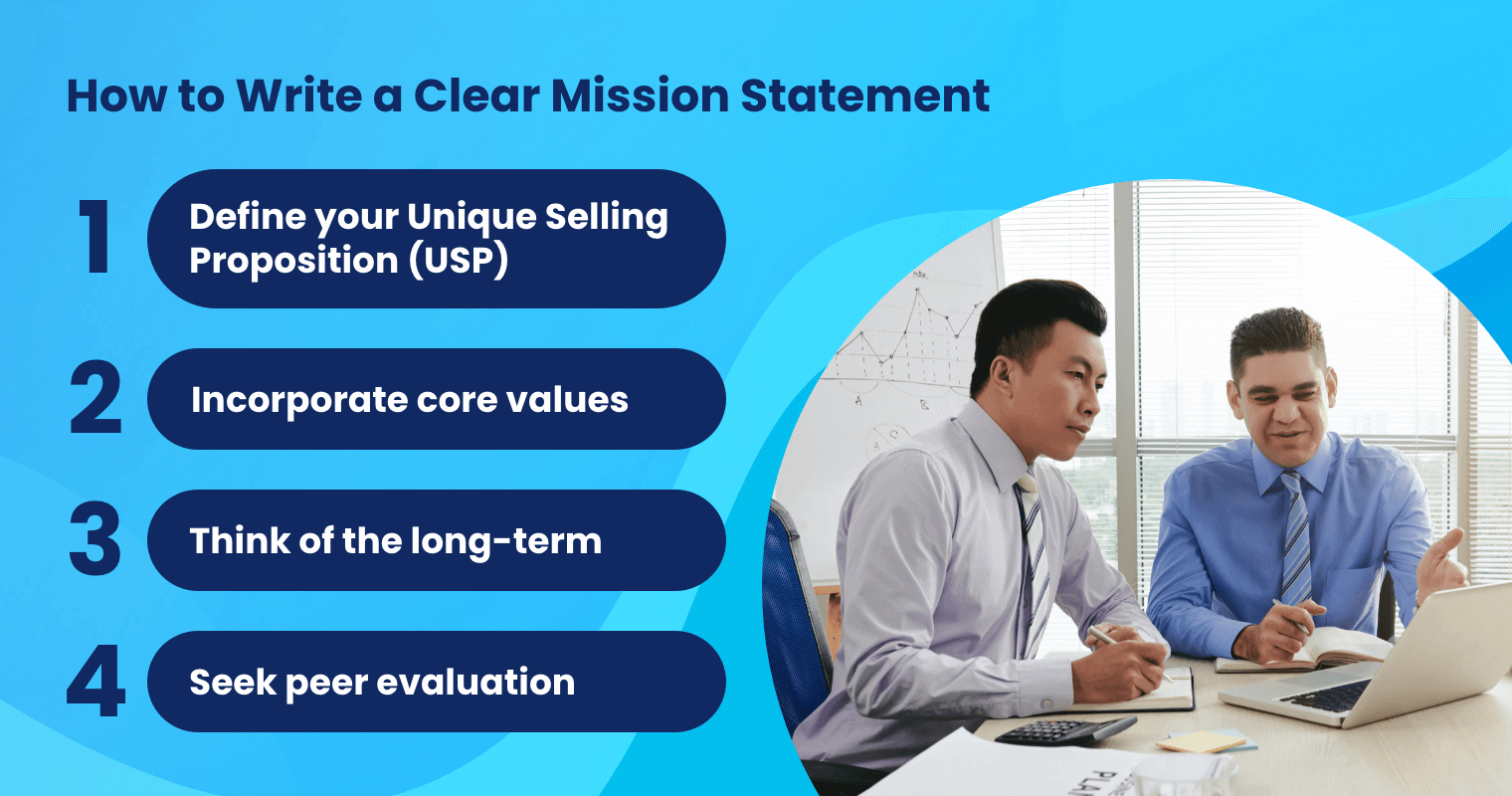
It is best practice to make mission statements clear and concise while showcasing the distinctive quality of an organization. Here are ways to achieve that:
1. Define your Unique Selling Proposition (USP)
Start by defining the organization’s essential aspects: its services, target market, industry, and the specific problems it seeks to address. By completing these foundational elements, an organization can establish its unique position in the market, differentiating itself from competitors and reinforcing its value proposition.
2. Incorporate core values
Next, embed the core values in the mission statement to enhance the brand image, fostering a stronger emotional connection with stakeholders. By putting values at the center of the mission, the statement becomes more than mere sentences but a shared belief that stakeholders can rally around.
3. Think of the long-term
Focus on crafting a mission statement that reflects the enduring vision of the organization. Avoid focusing on short-term goals, instead, prioritize a mission that can guide the organization over time. This ensures consistency in decision-making among leaders in the long term.
4. Seek peer evaluation
Before finalizing the mission statement, like with vision statements, seek stakeholders’ feedback. Engaging in discussions creates new perspectives that reveal improvement opportunities, empowering leaders to craft a well-rounded mission statement. This approach fosters inclusivity, strengthening relationships with stakeholders.
For key evaluators to experience seamless processes, board portals can be beneficial in this step. They have virtual rooms where team members can collaborate securely, ensuring timely voting and approvals.
Mission Statement Examples
To give more insights into the nuances of mission statements, here are examples:
- Walmart Inc.: “To save people money so they can live better.”
- Amazon.com, Inc.: “To be Earth’s most customer-centric company.”
- Google LLC: “To organize the world’s information and make it universally accessible and useful”
- Apple Inc.: “To bring the best user experience to customers through innovative hardware, software, and services.”
- Walt Disney Company: “To entertain, inform and inspire people around the globe through the power of unparalleled storytelling, reflecting the iconic brands, creative minds and innovative technologies that make ours the world’s premier entertainment company.”
- LinkedIn: “To connect the world’s professionals to make them more productive and successful.”
- Habitat for Humanity: “Seeking to put God’s love into action, Habitat for Humanity brings people together to build homes, communities and hope.”
- Harvard College: “Our mission to educate future leaders is woven throughout the Harvard College experience, inspiring every member of our community to strive toward a more just, fair, and promising world.”
- Alzheimer’s Association: “The Alzheimer’s Association leads the way to end Alzheimer’s and all other dementia — by accelerating global research, driving risk reduction and early detection, and maximizing quality care and support.”
- American Red Cross: “The American Red Cross, through its strong network of volunteers, donors and partners, is always there in times of need. Red Cross supporters provide a beacon of hope. From helping during disasters and ensuring access to lifesaving blood, to providing training to save lives and supporting military communities, the Red Cross is there when help can’t wait.”
Vision Statement vs Mission Statement: A Side-by-Side Comparison
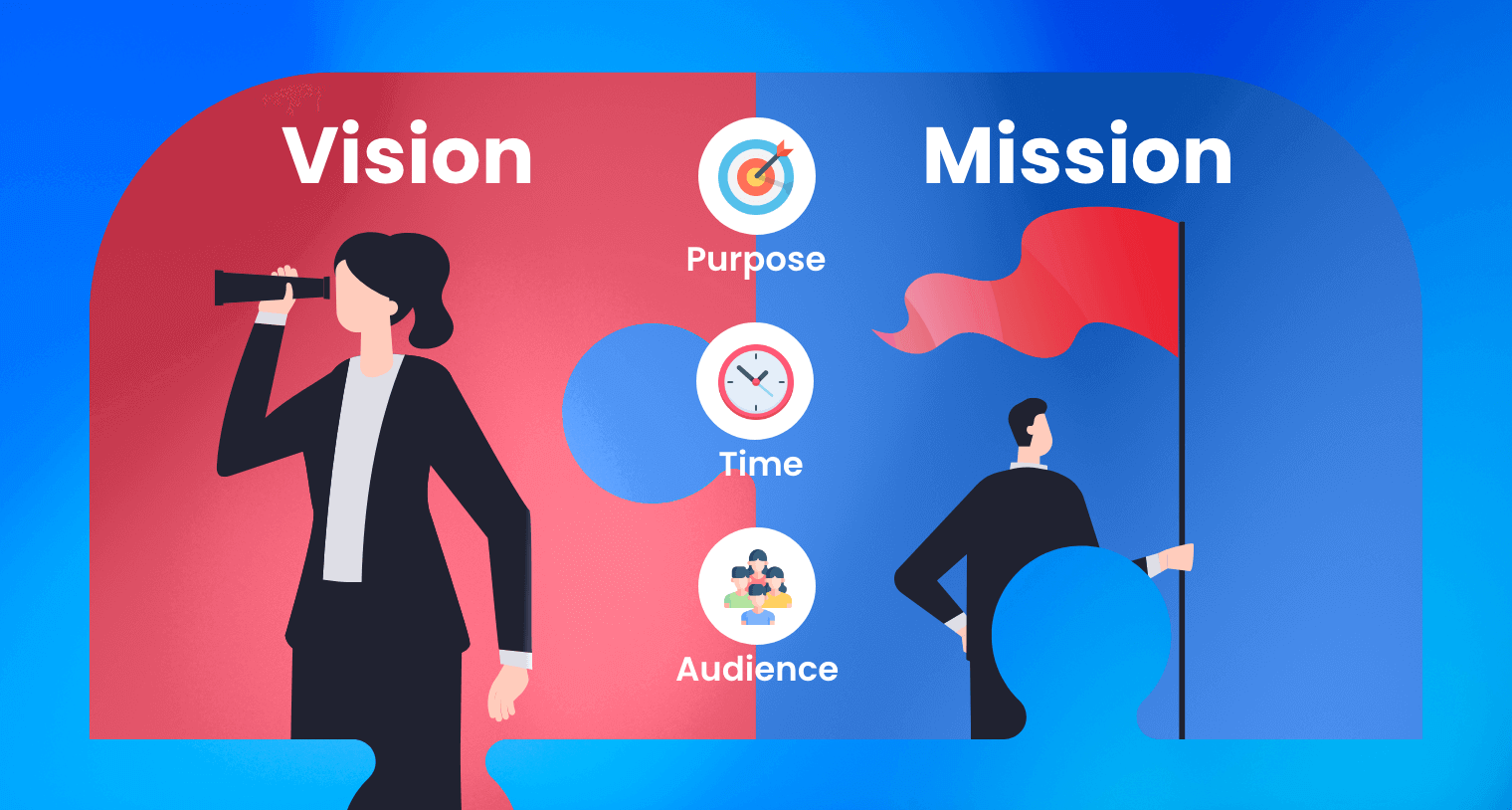
Because of their similarities, in some instances, people would combine them in one sentence. To fully utilize the impact of vision and mission statements, it is crucial to learn their subtle differences.
1. Purpose
Organizations use vision and mission statements side-by-side to convey their essence. Vision statements focus on why organizations exist, explaining the meaning behind their actions. On the other hand, mission statements answer the questions of what and how, summarizing strategies organizations plan to take toward their vision.
2. Time
This aspect is the most significant difference between vision and mission statements. While a mission statement outlines an organization’s current purpose and goals, a vision statement paints a picture of the ideal future an organization aims to achieve.
3. Audience
In general, these statements impact both internal and external stakeholders. However, given their purposes, vision statements are geared more toward leaders and employees to lead them in the right direction, and mission statements tend to be more public-facing, helpful in explaining to the general public what an organization does.
What is the purpose of mission and vision statements?
To fully understand the impact mission and vision statements have on organizations, here’s how board members can use them for strategic leadership:
1. Communicate an organization’s value to stakeholders
It’s easier for internal and external stakeholders to grasp an organization’s purpose and vision if expressed in concise, yet impactful sentences.
Internally, these help employees understand better the motivation behind strategies, encouraging more active participation. Externally, they provide valuable insights to investors or the general public in assessing whether the organization aligns with their purchasing or investment goals.
2. Inform strategy development
Board members and other high-level leaders leverage vision and mission statements to develop targeted strategies. Together, they form a solid foundation that empowers decision-makers in leading a purposeful and impactful organization.
3. Align KPIs
Crafting vision and mission statements is also crucial in streamlining KPI development to support organizational strategies. For example, with a mission like “provide innovative solutions to our customers,” decision-makers can use KPIs focused on customer satisfaction, product innovation rate, and time-to-market.
4. Strengthen brand differentiation
Clear and strong statements set an organization apart from its competitors. Defining characteristics and qualities, these statements highlight the core values and distinct services, helping the general public understand the brand better.
5. Cultivate organizational culture
Vision and mission statements embody the cultural blueprint of organizations. They are vital leadership materials for shaping and reinforcing the culture influencing employee behavior and decision-making.
Empower Purpose-Driven Organizations with Advanced Board Portal Technology

Creating a clear vision and mission is crucial for organizations of all sizes, whether nonprofit or corporate. To effectively implement and align these statements with
strategic objectives, modern leaders require tools that facilitate seamless collaboration, enhance governance, and drive impactful decision-making.
A leading digital solution in the market, Convene board portal empowers organizations to translate their vision and mission into actionable strategies. Packed with advanced features, it streamlines meeting management, document sharing, collaboration, and decision-making.
Here’s how Convene is an essential tool for modern organizations:
- Centralized Document Library: Store, organize, and access all board documents in one secure location. Designed with robust search capabilities and an intuitive folder system, Convene ensures that board members will find the right document at the right time.
- Agenda Builders: Build detailed agendas effortlessly with Convene’s drag-and-drop functionality. Easily attach supporting documents without hassle or time pressure.
- Review Rooms: Facilitate focused collaboration using Review Rooms. Within a secured virtual room, allow members to comment and share perspectives on specific topics or documents, fostering productive discussions and efficient decision-making.
- Secure Voting: Enable real-time and secure decision-making with digital voting, allowing organizations to maintain confidentiality during crucial sessions.
- Audit Trails: Strengthen accountability across the board with comprehensive audit trails. Convene can track user activities within the digital space, heightening compliance and providing an accurate record for future reference.
Ready to elevate your organization’s purpose and performance? Discover how Convene can transform your board operations today. Contact our sales team today to schedule an app walkthrough!
Jean is a Content Marketing Specialist at Convene, with over four years of experience driving brand authority and influence growth through effective B2B content strategies. Eager to deliver impactful results, Jean is a data-driven marketer who combines creativity with analytics. In her downtime, Jean relaxes by watching documentaries and mystery thrillers.


